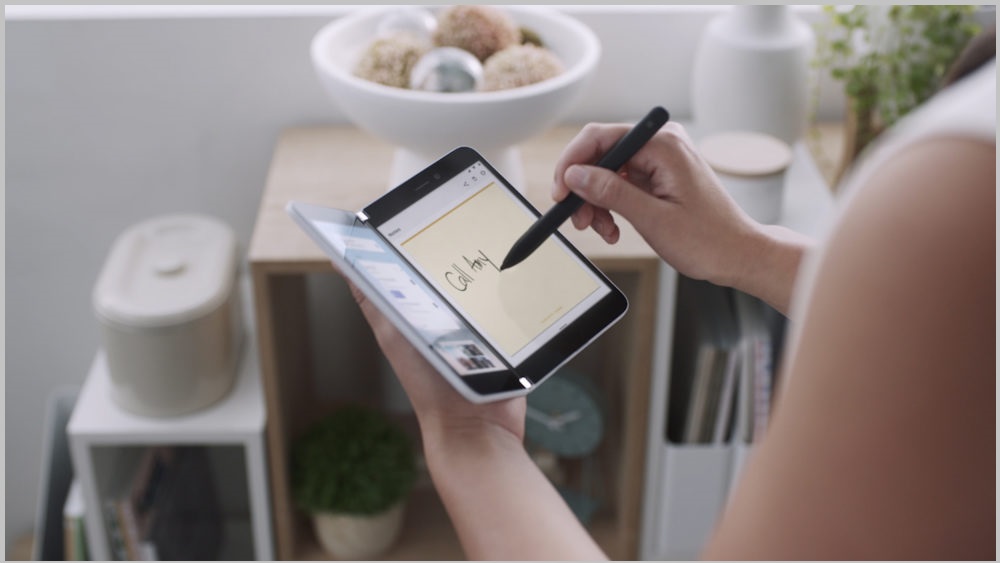Microsoft is back in the smartphone game, with the global tech giant unveiling a new foldable device which will run on the Android platform.
It’s the first phone Microsoft will have released in more than three years after previous attempts to compete with the likes of Apple and Google fell flat.
The Surface Duo will be a foldable smartphone running on the Android operating system, featuring two screens that fold together like a book. The two screens will be 5.6 inches, unfolding to form an 8.3 inch screen together.
Microsoft is forgoing its own operating system for the device, which will run on Google’s.
“The operating system is no longer the most important layer for us,” Microsoft CEO Satya Nadella told Wired.
“What is important for us is the app model and the experience. How people are going to write apps for Duo and Neo will have a lot more to do with each other than just writing a Windows app or an Android app, because it’s going to be about the Microsoft Graph.
It’s a bold move by Microsoft to go ahead with a foldable device after Samsung’s attempts this year have proved to be trouble-plagued.
But Microsoft chief product officer Panos Panay said foldable devices are the future.
“Think about when you sit at your desk and you have two screens,” Panay said. “You act very differently to when you have one screen - you’re about 40 percent more productive. The mind lights up and you can be more productive with apps side by side.”
The initial announcement for the Surface Duo was made at a Microsoft event late last week, but further details and specifics on the camera, display, battery life and price won’t be revealed until next year, with the device expected to be on sale by Christmas 2020.
“We have been working on this for several years and for me it had to be done,” Panay said. “Yes, we are showing our competition where we are going, but the more people that adopt it then the better off the people are.
“It’s good to share. I want developers to use two screens so next year you’ll pick up the product and you’ll love it and the apps are already there.”
The tech giant is also trying to not refer to the foldable device as a “phone”.
“It’s not a phone and I didn’t want to go there,” he said. “It’s a surface. We’re pushing the boundaries for what you can do with a product this small and we know scientifically that you’ll be more productive on it and that will lead to being more creative too.
“So calling it a phone felt wrong, it felt limiting. Look, you’ll make calls, you’ll download apps, but if we just called it a phone then it would take away from the product.”
Microsoft also announced a larger foldable tablet called the Surface Neo. The 5.6mm thin device will have two 9 inch displays connected by a 360-degree hinge, and will be able to be held like a book, tablet or laptop. It will feature a moveable keyboard that attaches magnetically and can be charged wirelessly.
The Surface Neo is also expected to be on sale by Christmas next year.
It’s not the first attempt from a tech giant to release a foldable tech device. Earlier this year Samsung revealed the Galaxy Fold, with a fragile 7.3 inch screen and a small 4.6 inch display.
The product was sent to tech reviewers in April this year but the release date was pushed back due to a number of faults being identified. The device was found to be very fragile, with some of the phones breaking after just a handful of folds, and an easily scratchable surface.
Many of the reviewers also removed a plastic film on the phone that was designed to protect it against damage.
The Galaxy Fold was released in Korea at the start of September, but there is no Australian release date now.
With the Surface Duo, Microsoft appears to be putting user experience front and centre above pursuing a futuristic-looking device, with a significant hinge aiming to help avoid many of the issues that Samsung has encountered.
Microsoft also unveiled details of several new devices and product updates. The latest Surface Pro 7 will finally include a USB-C port, while the Surface Pro X will be the slimmest laptop yet, clocking in at just 5.33mm thick.










